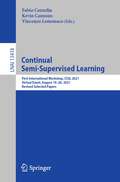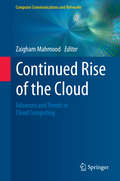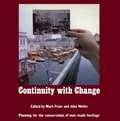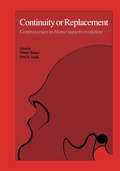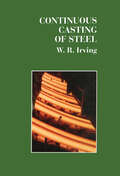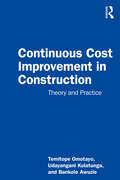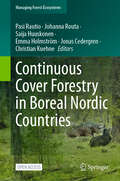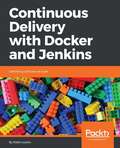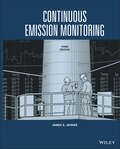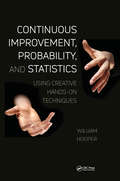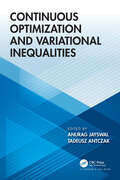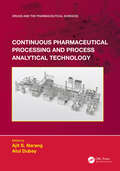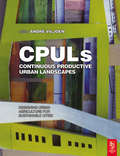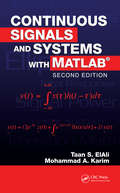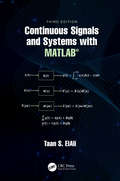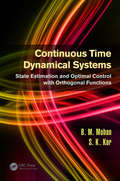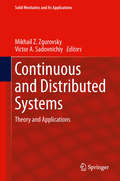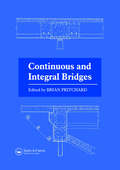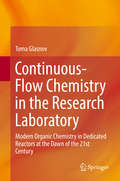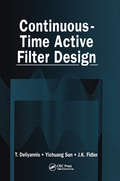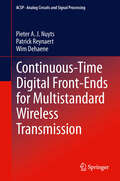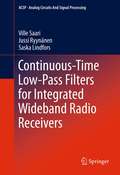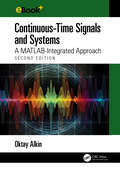- Table View
- List View
Continual Semi-Supervised Learning: First International Workshop, CSSL 2021, Virtual Event, August 19–20, 2021, Revised Selected Papers (Lecture Notes in Computer Science #13418)
by Fabio Cuzzolin Kevin Cannons Vincenzo LomonacoThis book constitutes the proceedings of the First International Workshop on Continual Semi-Supervised Learning, CSSL 2021, which took place as a virtual event during August 2021.The 9 full papers and 0 short papers included in this book were carefully reviewed and selected from 14 submissions.
Continued Rise of the Cloud: Advances and Trends in Cloud Computing (Computer Communications and Networks)
by Zaigham MahmoodThis book captures the state of the art in cloud technologies, infrastructures, and service delivery and deployment models. The work provides guidance and case studies on the development of cloud-based services and infrastructures from an international selection of expert researchers and practitioners. Features: presents a focus on security and access control mechanisms for cloud environments, analyses standards and brokerage services, and investigates the role of certification for cloud adoption; evaluates cloud ERP, suggests a framework for implementing "big data" science, and proposes an approach for cloud interoperability; reviews existing elasticity management solutions, discusses the relationship between cloud management and governance, and describes the development of a cloud service capability assessment model; examines cloud applications in higher education, including the use of knowledge-as-a-service in the provision of education, and cloud-based e-learning for students with disabilities.
Continuity With Change: Planning for the Conservation of Man-Made Heritage
by Mark Fram John Weiler"[Continuity with Change] seeks to document and demonstrate that middle positions between Change and Continuity are possible and desirable." — Canadian Architect "[Continuity with Change] is well produced with a large number of good photographs, maps, and drawings … obviously designed for a wide audience of planners and others active in heritage conservation." — The Journal of the Society for Industrial Archeology "[Continuity with Change] deserves a spot in the library of any professional who works regularly with older ubildings and their surroundings." — Plan Canada
Continuity or Replacement: Controversies in Homo Sapiens Evolution
by Günter Bräuer and Fred H. SmithThis volume is based on the symposium on controversies in 'Homo sapiens evolution' in Zagreb. It examines the competing models for modern human origins within the framework of present-day knowledge in the areas of human paleontology, paleolithic archaeology, and molecular genetics.
Continuous Biopharmaceutical Processes: Chromatography, Bioconjugation, and Protein Stability (Cambridge Series in Chemical Engineering)
by David Pfister Lucrèce Nicoud Massimo MorbidelliThis innovative reference provides a coherent and critical view on the potential benefits of a transition from batch to continuous processes in the biopharmaceutical industry, with the main focus on chromatography. It also covers the key topics of protein stability and protein conjugation, addressing the chemical reaction and purification aspects together with their integration. This book offers a fine balance between theoretical modelling and illustrative case studies, between fundamental concepts and applied examples from the academic and industrial literature. Scientists interested in the design of biopharmaceutical processes will find useful practical methodologies, in particular for single-column and multi-column chromatographic processes.
Continuous Casting of Steel
by W.R. IrvingThis monograph on the continuous casting of steel has been produced at the request of the Institute of Materials with the aim of providing university professionals and students, those already working in the steel industry and steel plant suppliers in related activities, with a concise account of the engineering, process and product technology of the continuous casting of steel and how this has been developed over recent years. is one of the series of monographs published by the Institute and particularly compliments a similar publication on the casting of aluminium. It covers the historical development of the process and the supply of liquid steel to the machine and describes in detail the various components of the main types of machines for the casting of billets, blooms and slabs respectively.
Continuous Cost Improvement in Construction: Theory and Practice
by Temitope Seun Omotayo Udayangani Kulatunga Bankole AwuzieContinuous Cost Improvement in Construction: Theory and Practice aims to provide students and practitioners with an all-inclusive understanding of strategies for adopting continuous improvement in construction cost management. This book addresses continuous improvement practices from the perspective of cost management and applies case study examples to question the readers’ perspective of continuous cost improvement strategies in the project lifecycle. Continuous cost improvement practices in managing the cost of minor, major, and mega projects are all connected with decision-making tools for devising strategies for choosing the approaches for mitigating the effect of cost overruns in construction projects. Continuous cost improvement should be taught as part of modern methods and processes of construction in further and higher education institutions. This book will be key reading for all advanced undergraduate and postgraduate courses in Construction Project Management, Building and Quantity Surveying. Professionals in all aspects of the AEC industry will also gain greatly from engaging with the key concepts of continuous cost improvement throughout this book.
Continuous Cover Forestry in Boreal Nordic Countries (Managing Forest Ecosystems #45)
by Pasi Rautio Johanna Routa Saija Huuskonen Emma Holmström Jonas Cedergren Christian KuehneThis open access book compiles the latest research on continuous cover forestry in boreal forests, highlighting both the need for additional information and the exciting possibilities that this method presents. Experts in the field explore topics such as forest regeneration, genetic effects, wood production and yield, wood harvesting, forest damage agents, biodiversity, water effects, carbon cycles of forests, economics, forest planning methods, multiple uses of forests, and forest owners' attitudes. As the world faces increasing pressure to balance the multiple goals of forest management, including raw material production, carbon sequestration, biodiversity, and climate change adaptation, it is becoming clear that different forest management methods are required. Even-aged forest management is well-researched, but continuous forest management is a newer and rapidly evolving approach that is gaining popularity in boreal forests. While an overall synthesis of the subject is not yet possible, this book provides an essential foundation for understanding the current state of continuous cover forestry in boreal forests. With the new research data being accumulated all the time, this book is an invaluable resource for researchers, policymakers, and forest managers who want to stay up-to-date on this important topic.
Continuous Cover Forestry: Assessment, Analysis, Scenarios (Managing Forest Ecosystems #23)
by Klaus Von Gadow Timo PukkalaAlthough the majority of the world's forest ecosystems are dominated by uneven-sized multi-species stands, forest management practice and theory has focused on the development of plantation monocultures to maximize the supply of timber at low cost. Societal expectations are changing, however, and uneven-aged multi-species ecosystems, selectively managed as Continuous Cover Forestry (CCF), are often believed to be superior to monocultures in addressing a wide range of expectations. This book presents methods which are relevant to CCF management and planning: analysing forest structures, silvicultural and planning, economic evaluation, based on examples in Europe, Asia, Africa and North and South America.
Continuous Delivery with Docker and Jenkins
by Rafał Leszko<P><P>Unleash the combination of Docker and Jenkins in order to enhance the DevOps workflow <P><P>Key Features <P><P>Build reliable and secure applications using Docker containers. <P><P>Create a complete Continuous Delivery pipeline using Docker, Jenkins, and Ansible. <P><P>Deliver your applications directly on the Docker Swarm cluster. <P><P>Create more complex solutions using multi-containers and database migrations. <P><P>Book Description <P><P>The combination of Docker and Jenkins improves your Continuous Delivery pipeline using fewer resources. It also helps you scale up your builds, automate tasks and speed up Jenkins performance with the benefits of Docker containerization. <P><P>This book will explain the advantages of combining Jenkins and Docker to improve the continuous integration and delivery process of app development. It will start with setting up a Docker server and configuring Jenkins on it. It will then provide steps to build applications on Docker files and integrate them with Jenkins using continuous delivery processes such as continuous integration, automated acceptance testing, and configuration management. <P><P>Moving on you will learn how to ensure quick application deployment with Docker containers along with scaling Jenkins using Docker Swarm. Next, you will get to know how to deploy applications using Docker images and testing them with Jenkins. <P><P>By the end of the book, you will be enhancing the DevOps workflow by integrating the functionalities of Docker and Jenkins. <P><P>What you will learn <P><P>Get to grips with docker fundamentals and how to dockerize an application for the Continuous Delivery process <P><P>Configure Jenkins and scale it using Docker-based agents <P><P>Understand the principles and the technical aspects of a successful Continuous Delivery pipeline <P><P>Create a complete Continuous Delivery process using modern tools: Docker, Jenkins, and Ansible <P><P>Write acceptance tests using Cucumber and run them in the Docker ecosystem using Jenkins <P><P>Create multi-container applications using Docker Compose <P><P>Managing database changes inside the Continuous Delivery process and understand effective frameworks such as Cucumber and Flyweight <P><P>Build clustering applications with Jenkins using Docker Swarm <P><P>Publish a built Docker image to a Docker Registry and deploy cycles of Jenkins pipelines using community best practices
Continuous Emission Monitoring
by James A. JahnkeCONTINUOUS EMISSION MONITORING The new edition of the only single-volume reference on both the regulatory and technical aspects of U.S. and international continuous emission monitoring (CEM) systems Continuous Emission Monitoring presents clear, accurate, and up-to-date information on the technical and regulatory issues that affect the design, application, and certification of CEM systems installed in power plants, cement plants, pulp and paper mills, smelters, and other stationary sources. Written by an international expert in the field, this classic reference guide covers U.S. and international CEM regulatory requirements, analytical techniques, operation and maintenance of CEM instrumentation, and more. The fully revised Third Edition remains the most comprehensive source of CEM information available, featuring three brand-new chapters on mercury monitoring, the reporting and certification of industrial greenhouse gas emissions, and the instrumentation and methods used to measure air toxic compounds including dioxins, furans, and hydrogen chloride. Thoroughly updated chapters discuss topics such as flow rate monitors, new EPA regulations, instrumentation and calibration techniques, CEM system control and data acquisition, and extractive system design. Providing environmental professionals with the knowledge of CEM systems necessary to address the present-day regulatory environment, Continuous Emission Monitoring: Discusses how CEM systems work, their advantages and limitations, and the regulatory requirements governing their operation Covers both the historical framework and technological basis of current CEM regulatory programs and standards in the United States, Canada, Europe, and Asia Offers practical guidance on sampling system selection, measurement techniques, advanced monitoring approaches, recordkeeping, and quality assurance Provides detailed technical descriptions of the technology necessary for regulatory compliance Includes new orthographic drawings to help instrument technicians and regulators with little technical background to easily understand key topics Continuous Emission Monitoring, Third Edition is an essential resource for professionals responsible for ensuring regulatory compliance, managers and technicians who purchase, operate, and maintain CEM instrumentation, regulatory personnel who write and enforce operating permits, and instructors and students in upper-level environmental engineering programs.
Continuous Improvement, Probability, and Statistics: Using Creative Hands-On Techniques (Continuous Improvement Series)
by William HooperWhat happens when the sport of Juggling meets a Statistical Process Control class? This book shows a creative approach to teaching data analysis for continuous improvement. Using step by step instructions, including over 65 photos and 40 graphs, traditional continuous improvement topics (design of experiments, reliability functions, and probability) are demonstrated using card illusions and hands-on activities. This book is for anyone that teaches these topics and wants to make them more understandable and sometimes even fun. Every operator, technician, student, manager, and leader can learn data analysis and be inspired to join the next generation of continuous improvement professionals.
Continuous Optimization and Variational Inequalities
by Anurag Jayswal Tadeusz AntczakThe proposed book provides a comprehensive coverage of theory and methods in the areas of continuous optimization and variational inequality. It describes theory and solution methods for optimization with smooth and non-smooth functions, for variational inequalities with single-valued and multivalued mappings, and for related classes such as mixed variational inequalities, complementarity problems, and general equilibrium problems. The emphasis is made on revealing generic properties of these problems that allow creation of efficient solution methods. Salient Features •The book presents a deep, wide-ranging introduction to the theory of the optimal control of processes governed by optimization techniques and variational inequality. •Several solution methods are provided which will help the reader to develop various optimization tools for real-life problems which can be modeled by optimization techniques involving linear and nonlinear functions. •The book focuses on most recent contributions in the nonlinear phenomena, which can appear in various areas of human activities. •This book also presents relevant mathematics clearly and simply to help solve real life problems in diverse fields such as mechanical engineering, management, control behavior, traffic signal, industry, etc. This book is aimed primarily at advanced undergraduates and graduate students pursuing computer engineering and electrical engineering courses. Researchers, academicians and industry people will also find this book useful.
Continuous Pharmaceutical Processing and Process Analytical Technology (Drugs and the Pharmaceutical Sciences)
by Ajit S. Narang Atul DubeyContinuous manufacturing of pharmaceuticals, including aspects of modern process development is highlighted in this book with both the ‘why’ and the ‘how’, emphasizing process modeling and process analytical technologies. Presenting specific case studies and drawing upon extensive experience from industry and academic opinion leaders, this book focuses on the practical aspects of continuous manufacturing. It gives the readers the strategic perspective and technical depth needed to adopt and implement these technologies, where appropriate, in order to gain the competitive edge in speed, agility, and reliability. Features : Discusses scientific solutions and process analytical technology to enable continuous manufacturing in the development of new drugs. Includes short stories about how some companies have adopted CM and what their drivers were and what benefits were realized. Addresses economic and practical considerations, unlike many other technical books. Emphasizes the practical aspects to give the reader the strategic imperative and technological depth to adopt and implement these technologies. Highlights the "why" and the "how", focusing on the need analysis and process modeling and process analytical technologies
Continuous Productive Urban Landscapes: Designing Urban Agriculture For Sustainable Cities
by Joe Howe Katrin Bohn Andre ViljoenThis book on urban design extends and develops the widely accepted 'compact city' solution. It provides a design proposal for a new kind of sustainable urban landscape: Urban Agriculture. By growing food within an urban rather than exclusively rural environment, urban agriculture would reduce the need for industrialized production, packaging and transportation of foodstuffs to the city dwelling consumers. The revolutionary and innovative concepts put forth in this book have potential to shape the future of our cities quality of life within them. Urban design is shown in practice through international case studies and the arguments presented are supported by quantified economic, environmental and social justifications.
Continuous Signals and Systems with MATLAB (Electrical Engineering Textbook Series)
by Mohammad A. Karim Taan S. ElAliDesigned for a one-semester undergraduate course in continuous linear systems, Continuous Signals and Systems with MATLAB, Second Edition presents the tools required to design, analyze, and simulate dynamic systems. It thoroughly describes the process of the linearization of nonlinear systems, using MATLAB to solve most examples and problems. With updates and revisions throughout, this edition focuses more on state-space methods, block diagrams, and complete analog filter design.
Continuous Signals and Systems with MATLAB® (Electrical Engineering Textbook Series #Vol. 1)
by Taan S. ElAliContinuous Signals and Systems with MATLAB® offers broad, detailed, and focused comprehensive coverage of continuous linear systems, based on basic mathematical principles. It presents many solved problems from various engineering disciplines using analytical tools as well as MATLAB. This book is intended primarily for undergraduate junior and senior electrical, mechanical, aeronautical, and aerospace engineering students. Practicing engineers will also find this book useful. This book is ideal for use in a one-semester course in continuous linear systems where the instructor can easily cover all of the chapters. Each chapter presents numerous examples that illustrate each concept. Most of the worked-out examples are first solved analytically, and then solved using MATLAB in a clear and understandable fashion. This book concentrates on explaining the subject matter with easy-to-follow mathematical development and numerous solved examples. The book covers traditional topics and includes an extensive coverage of state-space representation and analysis. The reader does not need to be fluent in MATLAB because the examples are presented in a self-explanatory way.
Continuous Time Dynamical Systems: State Estimation and Optimal Control with Orthogonal Functions
by B.M. Mohan S.K. KarOptimal control deals with the problem of finding a control law for a given system such that a certain optimality criterion is achieved. An optimal control is a set of differential equations describing the paths of the control variables that minimize the cost functional. This book, Continuous Time Dynamical Systems: State Estimation and Optimal Control with Orthogonal Functions, considers different classes of systems with quadratic performance criteria. It then attempts to find the optimal control law for each class of systems using orthogonal functions that can optimize the given performance criteria. Illustrated throughout with detailed examples, the book covers topics including: Block-pulse functions and shifted Legendre polynomials State estimation of linear time-invariant systems Linear optimal control systems incorporating observers Optimal control of systems described by integro-differential equations Linear-quadratic-Gaussian control Optimal control of singular systems Optimal control of time-delay systems with and without reverse time terms Optimal control of second-order nonlinear systems Hierarchical control of linear time-invariant and time-varying systems
Continuous and Distributed Systems: Theory and Applications (Solid Mechanics and Its Applications #211)
by Mikhail Z. Zgurovsky Victor A. SadovnichiyIn this volume, the authors close the gap between abstract mathematical approaches, such as abstract algebra, number theory, nonlinear functional analysis, partial differential equations, methods of nonlinear and multi-valued analysis, on the one hand, and practical applications in nonlinear mechanics, decision making theory and control theory on the other. Readers will also benefit from the presentation of modern mathematical modeling methods for the numerical solution of complicated engineering problems in hydromechanics, geophysics and mechanics of continua. This compilation will be of interest to mathematicians and engineers working at the interface of these field. It presents selected works of the open seminar series of Lomonosov Moscow State University and the National Technical University of Ukraine "Kyiv Polytechnic Institute". The authors come from Germany, Italy, Spain, Russia, Ukraine, and the USA.
Continuous and Integral Bridges
by Brian PritchardThis book contains the invited contributions to the 1993 Henderson Colloquium organised by the British Group of IABSE (International Association for Bridge and Structural Engineering). It provides an international review of new techniques of designing and constructing joint-free bridges - an approach which is rapidly being developed and used in man
Continuous-Flow Chemistry in the Research Laboratory: Modern Organic Chemistry in Dedicated Reactors at the Dawn of the 21st Century
by Toma GlasnovThis book presents a short introduction to the historical background to the field, the state of the art and a brief survey of the available instrumentation and the processing techniques used. The following major areas of interest in synthetic, organic and medicinal chemistry are elaborated on: transition-metal catalyzed reactions, organocatalytic transformations, heterocyclic synthesis, and photochemical reactions. Finally, selected applications in industry are also discussed. With its ample presentation of examples from recent literature, this is an essential and reliable source of information for both experienced researchers and postgraduate newcomers to the field.
Continuous-Time Active Filter Design (Electronic Engineering Systems #12)
by T. Deliyannis Yichuang Sun J.K. FidlerThis book presents the design of active RC filters in continuous time.Topics include:filter fundamentalsactive elementsrealization of functions using opampsLC ladder filtersoperational transconductance amplifier circuits (OTACs)MOSFET-C filtersContinuous-Time Active Filter Design uses wave variables to enable the reader to better understand the introduction of more complex variables created through linear transformations of voltages and currents.Intended for undergraduate students in electrical engineering, Continuous-Time Active Filter Design provides chapters as self-contained units, including introductory material leading to active RC filters.
Continuous-Time Digital Front-Ends for Multistandard Wireless Transmission (Analog Circuits and Signal Processing)
by Wim Dehaene Pieter A. J. Nuyts Patrick ReynaertThis book describes the design of fully digital multistandard transmitter front-ends which can directly drive one or more switching power amplifiers, thus eliminating all other analog components. After reviewing different architectures, the authors focus on polar architectures using pulse width modulation (PWM), which are entirely based on unclocked delay lines and other continuous-time digital hardware. As a result, readers are enabled to shift accuracy concerns from the voltage domain to the time domain, to coincide with submicron CMOS technology scaling. The authors present different architectural options and compare them, based on their effect on the signal and spectrum quality. Next, a high-level theoretical analysis of two different PWM-based architectures - baseband PWM and RF PWM - is made. On the circuit level, traditional digital components and design techniques are revisited from the point of view of continuous-time digital circuits. Important design criteria are identified and different solutions are presented, along with their advantages and disadvantages. Finally, two chips designed in nanometer CMOS technologies are described, along with measurement results for validation.
Continuous-Time Low-Pass Filters for Integrated Wideband Radio Receivers (Analog Circuits and Signal Processing)
by Ville Saari Saska Lindfors Jussi RyynänenThis book presents a new filter design approach and concentrates on the circuit techniques that can be utilized when designing continuous-time low-pass filters in modern ultra-deep-submicron CMOS technologies for integrated wideband radio receivers. Coverage includes system-level issues related to the design and implementation of a complete single-chip radio receiver and related to the design and implementation of a filter circuit as a part of a complete single-chip radio receiver. Presents a new filter design approach, emphasizing low-voltage circuit solutions that can be implemented in modern, ultra-deep-submicron CMOS technologies;Includes filter circuit implementations designed as a part of a single-chip radio receiver in modern 1.2V 0.13um and 65nm CMOS;Describes design and implementation of a continuous-time low-pass filter for a multicarrier WCDMA base-station;Emphasizes system-level considerations throughout.
Continuous-Time Signals and Systems: A MATLAB-Integrated Approach, Second Edition
by Oktay AlkinDrawing on author’s 30+ years of teaching experience, ”Continuous-Time Signals and Systems: A MATLAB Integrated Approach” represents a novel and comprehensive approach to understanding signals and systems theory. Many textbooks use MATLAB as a computational tool, but Alkin’s text employs MATLAB both computationally and pedagogically to provide interactive, visual reinforcement of fundamental concepts important in the study of continuous- time signals and systems.In addition to 210 traditional end-of-chapter problems and 168 solved examples, the book includes hands-on MATLAB modules consisting of: 77 MATLAB-based homework problems and projects (coordinated with the traditional end-of-chapter problems) 106 live scripts and GUI-based interactive apps that animate key figures and bring core concepts to life Downloadable MATLAB code for most of the solved examples 64 fully detailed MATLAB exercises that involve step by step development of code to simulate the relevant signal and/or system being discussed, including some case studies on topics such as synthesizers, simulating instrument sounds, pulse-width modulation, etc. The ebook+ version includes clickable links that allow running MATLAB code associated with solved examples and exercises in a browser, using the online version of MATLAB. It also includes audio files for some of the examples. Each module or application is linked to a specific segment of the text to ensure seamless integration between learning and doing. The aim is to not simply give the student just another toolbox of MATLAB functions, but to use the development of MATLAB code as part of the learning process, or as a litmus test of students’ understanding of the key concepts. All relevant MATLAB code is freely available from the publisher. In addition, a solutions manual, figures, presentation slides and other ancillary materials are available for instructors with qualifying course adoption.
